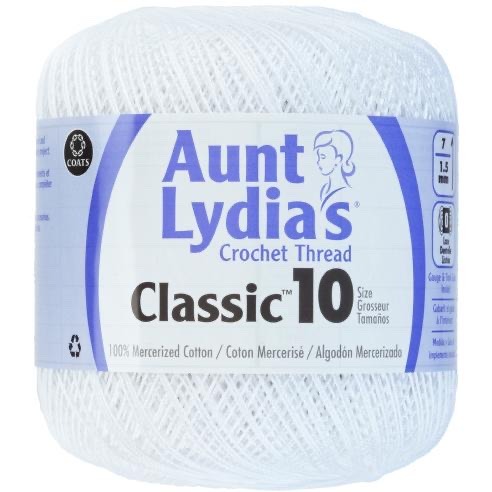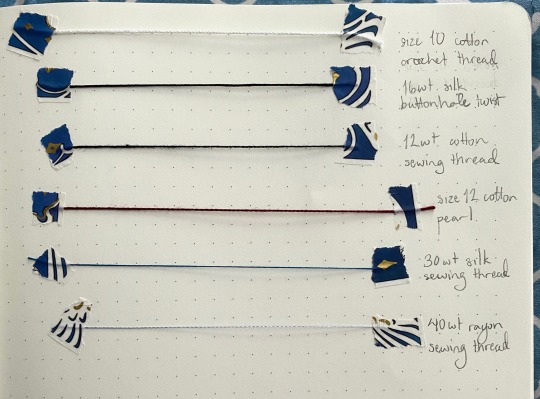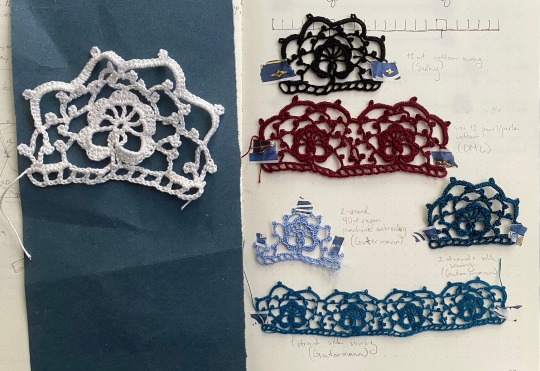#[<- using floss bc i can’t find my thread]
Explore tagged Tumblr posts
Text
i shouldn’t be allowed to have internet access past 10 pm bc my adhd suddenly leads me to believe that i can do anything and everything
#will mars fuck up their eyebrows? stick around and find out#i’m convinced that my ancestors have passed down ancient desi genes in the art of threading#it’s only kinda working lmao#[<- using floss bc i can’t find my thread]#mars rambles
7 notes
·
View notes
Text
Beginner’s Guide to Crochet Lace - Part 1B of who the fuck knows: Choosing Thread (so you can choose a pattern)
I’ve talked about this a lot in bits throughout my [#myth and pancake make underpinnings] posts but I’m going to get into more detail here.
When you google crochet lace, you’re going to get a lot of hits for this stuff:

It’s what crochet doilies and curtains are made out of, and it’s your basic, easily worked, traditional thread. Excellent choice for practice because it’ll get you used to using thin thread and a tiny hook.
But there are so many more (better) options that will better suit your needs. What exactly are your options?
Lace-weight yarn - exactly what it says on the tin. It’s a very fine yarn that is typically used for knitted lace. Can be very affordable or extremely expensive, depending on the fiber-content. Also known as cobweb or superfine. The sizing for lace-weight yarn is the most complicated and least consistent across brands, because a yarn that is 50 wraps per inch and one that is only 30 wraps (much thicker) will both be consider lace-weight. You’ll have lots of color and texture options, however.
Crochet thread (or crochet cotton, as I often call it, but there are some linen ones, I believe) - that’s the Aunt Lydia’s stuff. Comes in a range of sizes, but smaller weights are hard to find and only come in boring colors for the most part. Very consistent sizing, small numbers being the thickest, big numbers being thinner. 20-30 are the thinnest sizes you’ll be able to find easily, and probably only in white and off-whites (ecru or cream).
Pearl cotton - this is a type of embroidery thread that is very shiny and sturdy like a crochet thread but has a more noticeable twisted texture. Not really an issue at the size you’ll be using, and comes in a wide range of colors, because it’s usually used for embroidery. Also follows an inverse sizing scale, like crochet cotton, but it’s a different scale. Not many brands, but DMC has a pretty decent range of colors and is carried by Jo-Ann.
Embroidery floss - FRAGILE. It is loosely twisted to give it “spread” when doing embroidery, but this means it lacks density and strength. A hard pull will break the thread and it is prone to fraying. It only comes in short lengths, too. The one major advantage is the enormous range of colors and the affordability of cotton floss. No sizing scale, floss is floss. You can customize by increasing/decreasing the number of strands you use. If you insist on floss, I recommend a minimum of two strands.
Silk buttonhole twist or topstitching thread - comes on cards or spools, literally impossible to find in higher yardages, and expensive as all hell. As thick as thinner crochet cottons. You physically can make lace out of this and it would probably be very nice, but you literally just can’t buy enough of the stuff to make anything substantial.
Machine embroidery thread - I will talk about silk sewing thread later, here I want to focus on “art silk,” which is a fancy marketing name for artificial silk. This is going to be either polyester or rayon. I’ll talk more about the properties of various fibers later. Very shiny, inexpensive, comes in a few different weights (I haven’t tried these yet because I can’t get thicker weights locally). Sizing is also inverse but AGAIN VERY DIFFERENT from both crochet cotton and pearl cotton.
Machine sewing thread - polyester, cotton, and silk (also nylon but you’re probably not going to make lace out of nylon). Many sizes, from stupidly small and not usable for crochet, to as thick as the thinner crochet cottons. Uses the same sizing system as machine embroidery thread, but the actual thickness depends on fiber content. A 30wt cotton and 30wt silk are not the same. You can double up thread for thickness and sturdiness.
Turkish lace thread - almost always polyester, comes in very bright colors, super shiny. I have no idea where to reliably buy it and I’m morally opposed to using plastic whenever avoidable, but I’d be remiss not to mention it, because the stuff is literally designed for lace crochet.
OKAY. SO. Time to talk about FIBER CONTENT.
You got a lot of options if you use yarn, but honestly most of those options are not tiny-crochet friendly. Anything with wool in it, while soft and pretty, is going to be a BASTARD. Wool likes to catch onto itself, and unlike cotton does not come mercerized to prevent little fuzzies. Do not use wool for crochet lace unless you enjoy crying. Just don’t. Like, I’m using the most fiddly, tiny, bastard thread and I’m telling you wool is a terrible idea.
So what does that leave?
Rayon/viscose/“bamboo cotton” - not cotton at all! It’s reconsituted cellulose, which is fancy speak for plant stuff getting broken down into sludge using chemicals and then formed back into clean cellulose filament using more chemicals. It’s beautiful, can be matte or shiny as hell, and is often used for “art silk” aka artificial silk (the other most common fiber for art silk is polyester. blech). This is what @longsightmyth refers to as “slippery beautiful bastard rayon thread.” In machine embroidery thread, it is tightly twisted and less prone to catching on your hook, but is so fucking slippery. As yarn...good luck.
Cotton - actual cotton. We’re all familiar with this. It’s a sturdy, strong fiber, and easily the most beginner-friendly. It stays on your hook and is less likely to shift around or twist up weirdly while you work with it. Easy to find, cheap, lots of options. Also, you’ll notice a lot of threads say they’re “mercerized.” Mercerization is a process by which stray fuzzies are burnt off of the thread to leave it super smooth and shiny. I recommend size 20-30 crochet cotton for lace with some stiffness to it, or a 12wt sewing thread for something more flexible. You can go down as small as 30-40wt for extra-fine lace. Size 12 pearl cotton is also gorgeous and creates a compact lace with lots of structure.
Silk - the most expensive option, but worth the cost for a few reasons. This shit is strong. It’s smooth and shiny and is the least prone to fraying of all the fibers I’ve listed. Silk is... also weird. It’s not stretchy, per se, but silk sewing thread has a slight elasticity to it that cotton does not, making it incredibly fiddly as a single strand. The same smoothness that makes it beautiful makes it prone to slipping, but makes it a dream to work with doubled up. It also makes it much softer against the skin than cotton, but sturdy when using a heavier weight. Silk yarn is heavy and drapey and comes in many, many colors but will also gut your wallet. Silk machine embroidery thread is probably similar to sewing thread in terms of how it behaves but is shinier, and therefore slippery-er.
Polyester - fuck polyester.
BUT WHAT ABOUT SIZING?
Look. There’s a lot of sizing guides out there that explain what exactly each type of thread uses. They’re not helpful if you want to know how the different systems compare, and especially not if you’re trying to figure out if a non-crochet thread will look nice crocheted.
So here is a sizing guide of various common, easy to acquire threads relative to each other and how they look worked into a pattern.
From thickest to thinnest:
Size 10 crochet cotton
16wt silk buttonhole twist (not patterned bc I don’t have enough for a motif)
12wt cotton topstitching thread
Size 12 pearl cotton
30wt silk sewing thread, 2-strand
30wt silk sewing thread, 1 strand
30wt rayon machine embroidery thread


Notice what a massive fucking difference the size of the thread makes! Size 10 crochet thread is orders of magnitude larger than any of the other options! Two strands of rayon works up to approxiamately the same size as 2 strands of silk, but it’s stiffer.
Choose your threads according to the pattern and purpose, and vice versa! I’m doing a tiny lace edging on a delicate undergarment, so I want a super delicate lace to go with my super delicate cotton. If you’re trimming a jacket collar or dress bodice a size 12 pearl cotton or doubled silk would make more sense.
#this had been sitting in my drafts FOREVER but here it is#pancake talks lacemaking#pancake talks textiles
34 notes
·
View notes